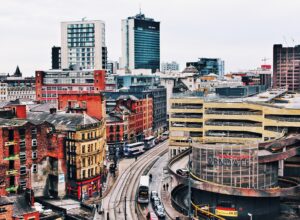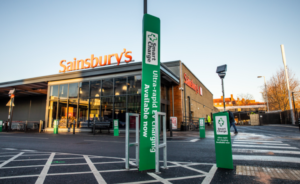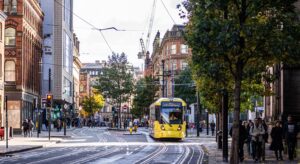Bad atmosphere: Inside Greater Manchester’s Chaotic Clean Air Zone
As plans to tackle traffic pollution in Manchester stall, Martin Guttridge-Hewitt explores how poor resourcing, lack of public information, and unrealistic expectations led proposals down a dead-end drive.
On a typically chilly afternoon in February, hundreds of taxis slowly snake through Manchester city centre. None are carrying passengers, instead all are here to protest.
It’s the latest display of anger over a proposed Greater Manchester Clean Air Zone, designed to bring particulate and nitrogen dioxide pollution below legal levels by 2024.
Debate on the subject has dominated local news for months. Facebook is flooded with memes painting city-region Mayor Andy Burnham as a villain hellbent on a hidden tax, and a Change.org petition against the scheme had over 55,000 signatures at the time of writing.
Phase one – covering HGVs, buses, coaches, and taxis licensed outside Greater Manchester – was due to launch May 30, 2022, when vehicles breaching Euro VI emissions standards would pay £60 per day to drive through the region. Stage two, for LGVs, minibuses, coaches, and taxis licensed by the county, would then begin on June 1, 2023, with non-compliance subject to daily fines between £7 and £10. Private cars, mopeds, and motorcycles were set to be fully exempt.

Concerns are understandable: £120m has been allocated for vehicle upgrades, a figure many believe is a fraction of what is needed. These fears are driven by sky high demand for commercial vehicles, with used vans increasing in cost by an average of 50% since the start of a pandemic that decimated the cash reserves of many businesses.
The size of the CAZ also sent out shockwaves, covering all 493 square miles of Greater Manchester. Firms outside this boundary are not eligible for grants, regardless of their need to travel into the zone, with others worried deliveries into the area could increase in price if suppliers opt to recoup charges from customers, rather than replacing vehicles.
Burnham is clear on his counter-argument – focusing charges on locations with poor air quality moves the problem on, as drivers plot alternative routes. Nevertheless, by late-January the Mayor had returned the matter to central government, reiterating requirements and financing were set in Westminster. He also requested to start the scheme as a non-charging CAZ this summer, with an extension of the air quality deadline to 2027.
Shortly after, Prime Minister Boris Johnson told the House of Commons the plan was ‘completely unworkable’, citing Labour’s economic negligence, and most recently the Department for Environment, Food and Rural Affairs (DEFRA) agreed to offer extra time. Targets must now be met by 2026, and a firm proposal of how that happens should be presented in July. Discussions on additional funding to help more upgrade have so far been notably absent.
‘Poor air quality is killing people, it’s as simple as that,’ says Chris Fletcher, Policy Director at Greater Manchester Chamber of Commerce. The UK’s largest, the body represents over 5,000 companies across the region, spanning ten boroughs including two cities, all of which are losing out as a result of pollution.
In 2018, think tank IPPR North and King’s College London published the only comprehensive study of air quality in Greater Manchester, and found up to £1.2bn was wiped off the region’s economy each year as a result of the toxic pollution. Based on a 2011 baseline, 3,687 premature deaths occurred in the area due to high pollution levels.
‘[The CAZ] has become a bit who said what – a government directive but Greater Manchester authorities have come up with the plan. It’s getting very, very politicised. There’s a bitterness around it, which isn’t helping, and I think there should have been a lot more done up front to really get into people’s vision of what is happening and what it means,’ Fletcher continues. ‘The number of times I’ve had to explain “it’s the whole of Greater Manchester and doesn’t include private cars” is unbelievable. And this is to people in senior positions.’
Uncertainty is everywhere, but as Fletcher reveals, his role as chair of a British Chambers of Commerce group tasked with analysing CAZs nationally shows this is not a Greater Manchester anomaly. Cities including Bradford, Birmingham, Liverpool, Bath, and Bristol are grappling with similar targets. ‘You hear stories all the time, the whole picture is very confusing, but ultimately these things are happening, they will come in, so there is a real identity problem, a communication problem.’
Despite this, Fletcher is quick to confirm his organisation has always maintained that air quality must be tackled. Pete Abel, from Friends of the Earth Manchester, shares this view, pointing out that 65-70% of transport emissions come from private journeys, so excluding these seems unfair. And this isn’t the only problematic part of the scheme, with the region attempting to tackle pollution while significantly expanding road infrastructure elsewhere.
‘Road widening doesn’t work,’ says Abel, nodding to a commonly understood phenomena whereby more capacity on the roads induces more traffic. ‘But the current administration seems to have thrown that evidence out of the window. Some of the road schemes we have objected to at the planning stage didn’t even model induced demand. The road from Stockport to Manchester Airport, the A6MARR, didn’t model induced demand. Yet it has been established for over 30 years that widening roads or building new ones doesn’t solve congestion.’
The M60 North West Quadrant on Greater Manchester’s orbital motorway is another case in point. Expected to cost upwards of £5.5bn, based on 2014 projections, the aim is to shave between three and five minutes from journey times. Significantly, the region’s motorways aren’t included in the CAZ due to a lack of government directive to National Highways. Yet overall investment dwarfs the £16m spent on 25 Greater Manchester cycle schemes, and £1.5bn paid for four new lines on the Metrolink tram network between 2010 to 2014, more than doubling size and capacity on a system powered by renewables.
‘What we still don’t see, and this applies at national government too, is that emission policies have to impact every decision we make,’ says Abel, referencing Manchester’s aims to be carbon neutral by 2038, while planning to almost double passenger numbers at Manchester Airport to 50 million per year by 2030. ‘Whether that’s procurement, planning, [or] building standards… How do we think we are going to achieve anything when we are making it harder to achieve anything?’
Claire Harding understands the impact of clean air traffic charging schemes. As Research Director at think tank Centre for London, she tells Air Quality News that the Congestion Charge Zone, Low Emissions Zone and Ultra Low Emission Zone (ULEZ) have delivered good results. Nevertheless, a January announcement from City Hall made it clear London was unlikely to meet its emissions targets in 2030, and a new, more comprehensive scheme may now be necessary. Crucially, though, this shouldn’t be a one-size-fits-all model.
‘I think it would be impossible to argue [the zones] haven’t made a difference. It’s early days for ULEZ, but it seems to be working in the sense of less polluting vehicles driving through central London. But they are very blunt instruments,’ she says. ‘We are inevitably moving, as London and as a country, towards road user charging, whereby you have some sort of pay per mile solution, but more responsive to what people actually do, covering greener vehicles, and trying to get people to drive outside rush hour.
‘We are going to see new ways of controlling and charging for use of our roads in the UK over the next decade. And it’s not necessarily even an environmental point about the climate crisis. It’s also a practical issue – the government needs to pay, somehow, for the expensive task of looking after Britain’s roads. If that’s not going to be road tax or fuel tax they have to come up with another way,’ she continues.
Sadly, Harding doesn’t believe technology or policies ‘are there yet’ to implement what people would deem a truly fair scheme, one that would take into account vehicle specifications, actual mileage, and time spent on the road. ‘What I must say is the charge cannot be zero for electric vehicles,’ she explains. ‘They still cause traffic jams and they still cause emissions to a degree. And we’re still going to have to find enough electricity to charge these vehicles.’
It’s a murky picture, and one that’s unlikely to become clearer any time soon. Putting politics and the pandemic recovery aside, everyone agrees urgent steps are needed to tackle air pollution in Greater Manchester and beyond, but what those steps entail is a different matter. Perhaps what’s most alarming, though, is the region’s CAZ represents the tip of the climate crisis iceberg.
Both outcry and shortcomings in proposals expose a troubling reality: the UK, its authorities, businesses and the public, still do not seem ready to acknowledge the level of investment and change needed to tackle this issue. The fact that’s just one of the myriad problems facing the planet at least makes one thing obvious. Facing up to the reality of our situation – and the true human, economic and environmental cost of inaction – would appear to be the only logical place to start.



















So why did I state to the GM Mayor, TFGM and a small number of those present at a meeting at the start of consultation “ The consultation was flawed”
It stated 13,800 PHV’s and 2,200 taxis carried out 32 million passengers and the busiest time for taxis and PHV’s is 10.00 – 16.00 hours ?
We have 3,200 Greater Manchester residents that went outside GM to be licensed and under the 2015 de regulation act it’s ok for those 3,200 drivers to work alongside GM licensed operators!
Some of the 13,800 and 2,200 taxis licensed in GM have two drivers on each vehicle! And we have a large number of out of town drivers that also work legitimately in GM!
The amount of jobs 32 million jobs wouldn’t pay for the hire of a vehicle, never mind, operator fees, fuel and wage Etc!
After several taxis and PHV’s having a device fitted, a Council officer agreed the 32 million trips was low!
The taxi and PHV trade are no different to peak time bus lane restrictions, my Mrs starts her transport assistant 7.15 taking school children to school, there’s hundreds if not thousands doing the same job, delivering special needs children! We take people to works shifts 24 hours a day, children to school then to colleges, at 10 am it’s break time, shower time!
The Government was blamed for giving wrong stats, how can TFGM and GMCA model air cleaning the with wrong stats on road usage ?
How can GMCA and TFGM plan our highways with wrong stats?
How can GMCA and TFGM know what type of passengers we carry if the stats are wrong?
If GMCA want less vehicles on the road, then get the Government to do away with the 2015 deregulation act, as it causes vehicle owners from outside GM to travel into GM to work!
There are other ways to reduce emissions, I asked more than one councillor to suspend bus lanes on one road to see the negatives and positives of doing so around 8 years ago, it was a blunt no!
Eventually I contacted a ward councillor who had the political to listen and act, the local community ward wanted them to be suspended, finally with tram line works on another another road, it was decided to suspend the bus lanes, with around 21-22 buses an hour on either side, it’s kept that way, buses and other traffic keeps moving, not only reducing emissions but the local economy has benefited, the number of hospital patients arriving late has decreased!
So I’d ask, What’s more important buses arriving a few minutes late ( they don’t on this road) or reducing congestion – emissions?
In 1974-5 GM buses carried 540 million passengers, in 2014 its down to just over 200 million, less buses, less routes, less overall miles, Why are TfGM and GMCA still putting in new bus lanes? What constitutes putting in 24 hour restrictions or peak time only?
GMCA need to look why people no longer cycle or walk to work or shops?
I’m 68 I remember Lancashire wakes weeks, where we had large factories with major employers that employed thousands of local residents and row upon row of local shops where people walked or cycled to work or the local shop!
The M60 is busy for a reason, people drive to work outside the area they live in!
It’s alleged the dole place requests people looking for a job to be able to travel for up to a hour away from home!
If we want people to cycle and walk, then we need GMCA and the GM Mayor to combine there efforts to bring back major employers to all ten Greater Manchester areas!
There are other ways to lower emissions !
I reported these traffic lights as being faulty to TFGM in December due to the traffic lights staying on red longer than green, with congestion building up 1/2 mile to only allow 3-4 vehicles through on a main road, a fault was found and corrected in February! On a group Facebook page, many have complained wrongly or rightly about traffic lights failing to keep traffic moving!